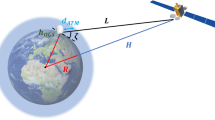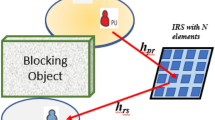Abstract
Unlike Rayleigh or Nakagami-m fading which has been widely studied in hybrid satellite-terrestrial relay network, the multi-branch Weibull fading which can be an alternative has been less studied due to its high intractability. In the proposed satellite-terrestrial Weibull system, by applying multi-branch optimal transmitting beamforming/receiving combination strategy, an upper bound of signal to noise (SNR) based outage probability (OP) is analyzed compared with the exact OP. Besides, two different methods are used to calculate the intractable Ergodic Capacity. Moreover, the closed-form expressions of the average symbol error rate (ASER) and Effective Capacity are hard to derive. Hence, simplified theoretical results of ASER and Effective Capacity are presented via the proposed upper bound of SNR scheme. Finally, various parameters are verified to illustrate the performance of the proposed model and demonstrate the effectiveness of our method.






Similar content being viewed by others
References
Bhatnagar, M. R., & Arti M. K. (2013). Performance analysis of AF based hybrid satellite-terrestrial cooperative network over generalized fading channels. IEEE Communications Letters, 17(10), 1912-1915.
Upadhyay, P. K., & Sharma, P. K. (2016). Max-Max user-relay selection scheme in multiuser and multirelay hybrid satellite-terrestrial relay systems. IEEE Communications Letters, 20(2), 268–271.
Upadhyay, P. K., & Sharma, P. K. (2016). Multiuser hybrid satellite-terrestrial relay networks with co-channel interference and feedback latency. In 2016 European Conference on Networks and Communications (EuCNC), Athens (pp. 174–178).
Sharma, P. K., Gupta, D., & Kim, D. I. (2020). Cooperative AF-based 3D mobile UAV relaying for hybrid satellite-terrestrial networks. In IEEE 91st Vehicular Technology Conference (VTC2020-Spring). Antwerp, Belgium (pp. 1–5).
Sharma, P. K., & Kim, D. I. (2020). Secure 3D mobile UAV relaying for hybrid satellite-terrestrial networks. IEEE Transactions on Wireless Communications, 19(4), 2770–2784.
Sharma, P. K., Deepthi, D., & Kim, D. I. (2020). Outage probability of 3-D mobile UAV relaying for hybrid satellite-terrestrial networks. IEEE Communications Letters, 24(2), 418–422.
An, K., Li, Y., Yan, X., & Liang, T. (2019). On the Performance of Cache-Enabled Hybrid Satellite-Terrestrial Relay Networks. IEEE Wireless Communications Letters, 8(5), 1506–1509. https://doi.org/10.1109/LWC.2019.2924631.
Yan, X., Xiao, H., Wang, C., & An, K. (2018). Outage performance of NOMA-based hybrid satellite-terrestrial relay networks. IEEE Wireless Communications Letters, 7(4), 538–541.
Zhang, X., An, K., Zhang, B., Chen, Z., Yan, Y., & Guo, D. (2020). Vickrey auction-based secondary relay selection in cognitive hybrid satellite-terrestrial overlay networks with non-orthogonal multiple access. IEEE Wireless Communications Letters, 9(5), 628–632.
Bithas, P. S., Karagiannidis, G. K., Sagias, N. C., Mathiopoulos, P. T., Kotsopoulos, S. A., & Corazza, G. E. (2005). Performance analysis of a class of GSC receivers over nonidentical Weibull fading channels. IEEE Transactions on Vehicular Technology, 54(6), 1963–1970.
Sagias, N. C., Zogas, D. A., & Karagiannidis, G. K. (2005). Selection diversity receivers over nonidentical Weibull fading channels. IEEE Transactions on Vehicular Technology, 54(6), 2146–2151.
Kwan, R., & Leung, C. (2007). General order selection combining for Nakagami and Weibull fading channels. IEEE Transactions on Wireless Communications, 6(6), 2027–2032.
Kolawole, O. Y., Vuppala, S., Sellathurai, M., & Ratnarajah, T. (2017). On the performance of cognitive satellite-terrestrial networks. IEEE Transactions on Cognitive Communications and Networking, 3(4), 668–683.
Liu, X., Kong, H., Lin, M., & Zhu, W. (2019). Outage performance of the integrated satellite-terrestrial network based on the SNR threshold. In 12th International Congress on Image and Signal Processing, BioMedical Engineering and Informatics (CISP-BMEI). Suzhou, China (pp. 1–5).
Abdi, A., Lau, W. C., Alouini, M., & Kaveh, M. (2003). A new simple model for land mobile satellite channels: Lfirst- and second-order statistics. IEEE Transactions on Wireless Communications, 2(3), 519-528.
El Bouanani, F., & Ben-Azza, H. (2015). Efficient performance evaluation for EGC, MRC and SC receivers over Weibull multipath fading channel. In: Conference: 10th International Conference on Cognitive Radio Oriented Wireless Networks (CROWNCOM’15), Doha, Qatar, pp. 346-357.
Di Renzo, M., Graziosi, F., & Santucci, F. (2010). Channel capacity over generalized fading channels: A novel MGF-based approach for performance analysis and design of wireless communication systems. IEEE Transactions on Vehicular Technology, 59(1), 127–149.
Yang, N., Yeoh, P. L., Elkashlan, M., Yuan, J., & Collings, I. B. (2012). Cascaded TAS/MRC in MIMO multiuser relay networks. IEEE Transactions on Wireless Communications, 11(10), 3829–3839.
Adamchik, V.S., & Marichev, O.I. (1990). The algorithm for calculating integrals of hypergeometric type functions and its realization in reduce systems. In Proc. Int. Conf. Symp. Algebraic Comput, pp. 212–224.
Gradshteyn, I. S., & Ryzhik, I. M. (2007). Table of Integrals, Series, and Products (7th ed.). New York, NY, USA: Academic.
Agrawal, R. P. (1970). Certain transformation formulae and Meijer’s G function of two variables. Indian Journal of Pure Applied and Mathematics, 1(4), 537–551.
Wolfram. The Wolfram functions site (online) available at http://functions.wolfram.com
Wu, D., & Negi, R. (2003). Effective capacity: A wireless link model for support of quality of service. IEEE Transactions on Wireless Communications, 2(4), 630–643.
Acknowledgements
This work is supported by Postgraduate Research and Practice Innovation Program of Jiangsu Province (KYCX20-0202).
Author information
Authors and Affiliations
Corresponding author
Additional information
Publisher's Note
Springer Nature remains neutral with regard to jurisdictional claims in published maps and institutional affiliations.
Appendices
Appendix A
As is depicted in Eq. (7), \(I_1\) is derived as
With the help of polynomial expansion Eq.(1.111) in [20], then we make use of the transformation of Meijer’s G-function in Eq.(07.34.03.0046.01) in [22] and Eq. (10) in [19], the integral operation can be solved by Eq. (3.1) in [21]. The closed form of \(I_1\) is shown as:
where b denotes \({{\left[ {\left( {\beta - \delta } \right) {r_{th}}\left( {{r_{th}} + 1} \right) } \right] } \big / {\left( {{c_{sr}}{{{{\bar{\gamma }}} }_s}} \right) }}\), a represents \(1-p\), c is \(l + \varPhi - 1\).
Finally, by substituting Eq. (44) into Eq. (11) and with several mathematical simplification, we get the expression of Outage Probability given in Eq. (12).
Appendix B
By substituting Eq. (24) into Eq. (23), \({{{\bar{C}}}_3}\) can be transformed as
With the aid of Eq. (10) in [19] and Eq. (3.1) in [21], we can obtain the results of \(I_2\), \(I_3\) given as follows:
Finally, by substituting the calculation results into Eq. (45) and with several mathematical manipulations, the last term of \({{\bar{C}}}\) is shown as Eq. (24).
Appendix C
As is shown in Eq. (38), we can know that MGF is needed to calculate the Effective Capacity. However, the third term in Eq. (32) cannot be used for calculating directly.Herein, we provide an alternative method based on the approximate instead. Substituting Eq. (13) into Eq. (31), where \(\exp \left[ { - \left( {s + \frac{{\beta - \delta }}{{{{{{\bar{\gamma }}} }_s}}}} \right) x} \right]\) can be approximated by \(\sum \limits _{l = 0}^L {\frac{{{{\left[ { - \left( {s + \frac{{\beta - \delta }}{{{{{{\bar{\gamma }}} }_s}}}} \right) } \right] }^l}}}{{l!}}} {x^l}\) at the time \({{{\bar{\gamma }}} _s}\) goes to infinity, thus the novel MGF can be given as
where \(\sum \limits _{{i_1}, \cdots ,{i_M},p} {{\varphi _{{i_1}, \cdots ,{i_M},p}}} = \sum \limits _{{i_1} = 0}^{{m_s} - 1} { \cdots \sum \limits _{{i_M} = 0}^{{m_s} - 1} {\frac{{\varXi \left( M \right) }}{{c_{sr}^\varLambda {{\bar{\gamma }}} _s^\varLambda }}\sum \limits _{p = 0}^{\varLambda - 1} {\frac{{\varGamma \left( \varLambda \right) }}{{p!}}} {{\left( {\frac{{\beta - \delta }}{{{c_{sr}}{{{{\bar{\gamma }}} }_s}}}} \right) }^{ - \left( {\varLambda - p} \right) }}} }\).
Rights and permissions
About this article
Cite this article
Teng, T., Yu, X., Li, M. et al. Performance Analysis of Satellite-Terrestrial Network of Weibull Fading Channel. Wireless Pers Commun 119, 1–19 (2021). https://doi.org/10.1007/s11277-020-07889-9
Accepted:
Published:
Issue Date:
DOI: https://doi.org/10.1007/s11277-020-07889-9




